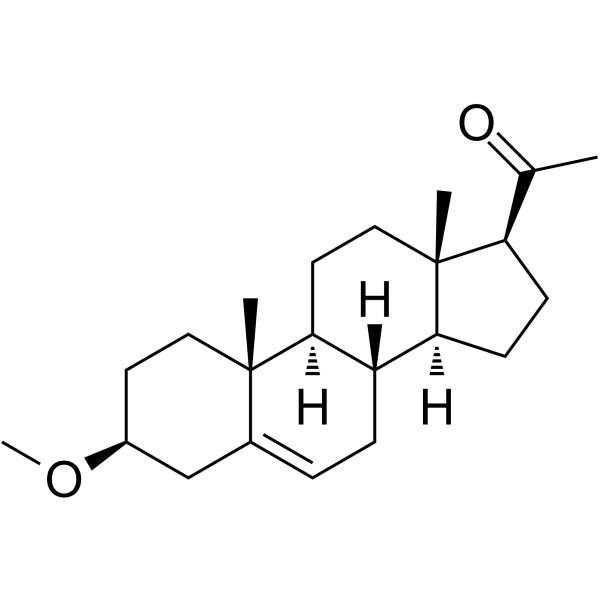Physicochemical Properties
| Molecular Formula | C22H34O2 |
| Molecular Weight | 330.50 |
| Exact Mass | 330.256 |
| CAS # | 511-26-2 |
| Related CAS # | MAP4343-d4 |
| PubChem CID | 233254 |
| Appearance | White to off-white solid powder |
| Density | 1.04g/cm3 |
| Boiling Point | 426.6ºC at 760mmHg |
| Flash Point | 161.3ºC |
| Index of Refraction | 1.529 |
| LogP | 5.169 |
| Hydrogen Bond Donor Count | 0 |
| Hydrogen Bond Acceptor Count | 2 |
| Rotatable Bond Count | 2 |
| Heavy Atom Count | 24 |
| Complexity | 564 |
| Defined Atom Stereocenter Count | 7 |
| SMILES | CC(=O)[C@H]1CC[C@@H]2[C@@]1(CC[C@H]3[C@H]2CC=C4[C@@]3(CC[C@@H](C4)OC)C)C |
| InChi Key | ZVGQOQHAMHMMNE-BIBIXIOVSA-N |
| InChi Code | InChI=1S/C22H34O2/c1-14(23)18-7-8-19-17-6-5-15-13-16(24-4)9-11-21(15,2)20(17)10-12-22(18,19)3/h5,16-20H,6-13H2,1-4H3/t16-,17-,18+,19-,20-,21-,22+/m0/s1 |
| Chemical Name | 1-[(3S,8S,9S,10R,13S,14S,17S)-3-methoxy-10,13-dimethyl-2,3,4,7,8,9,11,12,14,15,16,17-dodecahydro-1H-cyclopenta[a]phenanthren-17-yl]ethanone |
| HS Tariff Code | 2934.99.9001 |
| Storage |
Powder-20°C 3 years 4°C 2 years In solvent -80°C 6 months -20°C 1 month |
| Shipping Condition | Room temperature (This product is stable at ambient temperature for a few days during ordinary shipping and time spent in Customs) |
Biological Activity
| ln Vitro | In vitro, microtubule polymerization is stimulated by MAP4343 (40 μM; 15 or 30 min)[1]. In PC12 cells, MAP4343 (30 μM; 2–8 d) increases neurite outgrowth induced by nerve growth factor (NGF)[1]. In PC12 cells, MAP4343 (20 μM; 1 h) guards against microtubule depolymerization brought on by nocodazole[1]. |
| ln Vivo | Rats with spinal cord injury (SCI) recover more quickly after taking MAP4343 (12 mg/kg; sc daily for 28 days)[2]. After SCI in rats, MAP4343 (4 mg/kg; daily SC for 6 days) raises MAP2 levels in the spinal cord[2]. After SCI in rats, MAP4343 (4 mg/kg; daily sc for 6 d) increases the size of the dendritic arbours of lumbar spinal motoneurons[2]. |
| Animal Protocol |
Animal/Disease Models: Adult SD (Sprague-Dawley) male rats with spinal cord injury[2] Doses: 12 mg/kg Route of Administration: Daily sc for 28 days Experimental Results: Increased the number of animals able to walk with weight-supported plantar steps. demonstrated forelimb-hindlimb coordination at the end of the study. |
| References |
[1]. Microtubule-associated protein 2 (MAP2) is a neurosteroid receptor. Proc Natl Acad Sci U S A. 2006 Mar 21;103(12):4711-6. [2]. Treatment of experimental spinal cord injury with 3β-methoxy-pregnenolone. Brain Res. 2011 Jul 27;1403:57-66. |
Solubility Data
| Solubility (In Vitro) | DMSO : 25 mg/mL (75.64 mM) |
| Solubility (In Vivo) |
Solubility in Formulation 1: 2.5 mg/mL (7.56 mM) in 10% DMSO + 40% PEG300 + 5% Tween80 + 45% Saline (add these co-solvents sequentially from left to right, and one by one), suspension solution; with sonication. For example, if 1 mL of working solution is to be prepared, you can add 100 μL of 25.0 mg/mL clear DMSO stock solution to 400 μL PEG300 and mix evenly; then add 50 μL Tween-80 to the above solution and mix evenly; then add 450 μL normal saline to adjust the volume to 1 mL. Preparation of saline: Dissolve 0.9 g of sodium chloride in 100 mL ddH₂ O to obtain a clear solution. Solubility in Formulation 2: ≥ 2.5 mg/mL (7.56 mM) (saturation unknown) in 10% DMSO + 90% Corn Oil (add these co-solvents sequentially from left to right, and one by one), clear solution. For example, if 1 mL of working solution is to be prepared, you can add 100 μL of 25.0 mg/mL clear DMSO stock solution to 900 μL of corn oil and mix evenly. (Please use freshly prepared in vivo formulations for optimal results.) |
| Preparing Stock Solutions | 1 mg | 5 mg | 10 mg | |
| 1 mM | 3.0257 mL | 15.1286 mL | 30.2572 mL | |
| 5 mM | 0.6051 mL | 3.0257 mL | 6.0514 mL | |
| 10 mM | 0.3026 mL | 1.5129 mL | 3.0257 mL |
